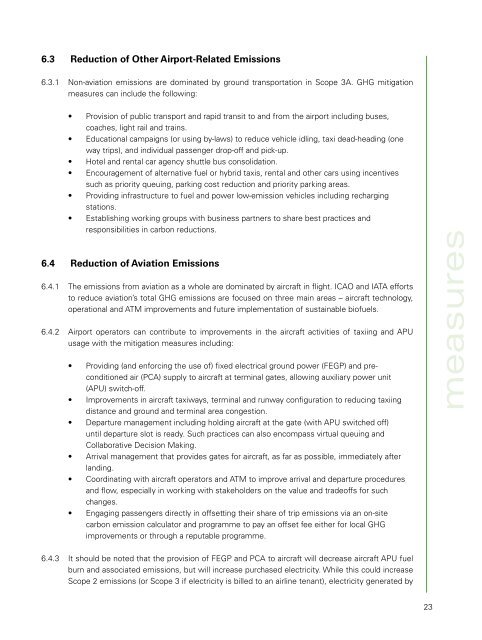Airport Greenhouse Gas Emissions Management - Zurich Airport
Airport Greenhouse Gas Emissions Management - Zurich Airport
Airport Greenhouse Gas Emissions Management - Zurich Airport
You also want an ePaper? Increase the reach of your titles
YUMPU automatically turns print PDFs into web optimized ePapers that Google loves.
6.3 Reduction of Other <strong>Airport</strong>-Related <strong>Emissions</strong><br />
6.3.1 Non-aviation emissions are dominated by ground transportation in Scope 3A. GHG mitigation<br />
measures can include the following:<br />
• Provision of public transport and rapid transit to and from the airport including buses,<br />
coaches, light rail and trains.<br />
• Educational campaigns (or using by-laws) to reduce vehicle idling, taxi dead-heading (one<br />
way trips), and individual passenger drop-off and pick-up.<br />
• Hotel and rental car agency shuttle bus consolidation.<br />
• Encouragement of alternative fuel or hybrid taxis, rental and other cars using incentives<br />
such as priority queuing, parking cost reduction and priority parking areas.<br />
• Providing infrastructure to fuel and power low-emission vehicles including recharging<br />
stations.<br />
• Establishing working groups with business partners to share best practices and<br />
responsibilities in carbon reductions.<br />
6.4 Reduction of Aviation <strong>Emissions</strong><br />
6.4.1 The emissions from aviation as a whole are dominated by aircraft in flight. ICAO and IATA efforts<br />
to reduce aviation’s total GHG emissions are focused on three main areas – aircraft technology,<br />
operational and ATM improvements and future implementation of sustainable biofuels.<br />
6.4.2 <strong>Airport</strong> operators can contribute to improvements in the aircraft activities of taxiing and APU<br />
usage with the mitigation measures including:<br />
• Providing (and enforcing the use of) fixed electrical ground power (FEGP) and preconditioned<br />
air (PCA) supply to aircraft at terminal gates, allowing auxiliary power unit<br />
(APU) switch-off.<br />
• Improvements in aircraft taxiways, terminal and runway configuration to reducing taxiing<br />
distance and ground and terminal area congestion.<br />
• Departure management including holding aircraft at the gate (with APU switched off)<br />
until departure slot is ready. Such practices can also encompass virtual queuing and<br />
Collaborative Decision Making.<br />
• Arrival management that provides gates for aircraft, as far as possible, immediately after<br />
landing.<br />
• Coordinating with aircraft operators and ATM to improve arrival and departure procedures<br />
and flow, especially in working with stakeholders on the value and tradeoffs for such<br />
changes.<br />
• Engaging passengers directly in offsetting their share of trip emissions via an on-site<br />
carbon emission calculator and programme to pay an offset fee either for local GHG<br />
improvements or through a reputable programme.<br />
measures<br />
6.4.3 It should be noted that the provision of FEGP and PCA to aircraft will decrease aircraft APU fuel<br />
burn and associated emissions, but will increase purchased electricity. While this could increase<br />
Scope 2 emissions (or Scope 3 if electricity is billed to an airline tenant), electricity generated by<br />
23

















